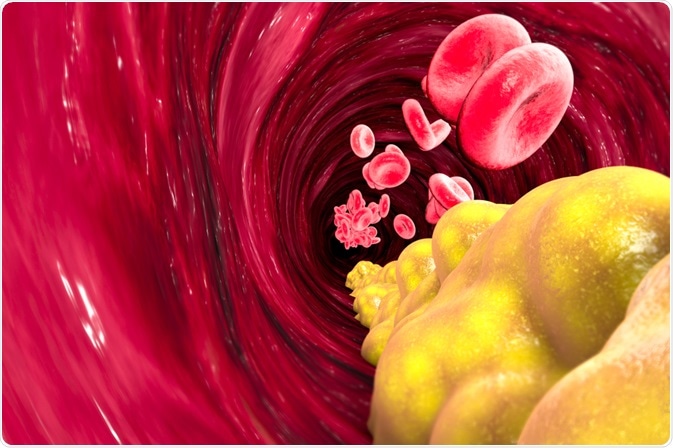Cholesterol is a multi-functional lipid that has been studied heavily for many years. It is essential to several aspects of neuronal, immune, hepatocyte (liver) and viral biology, as well as a key constituent of a majority of cell membranes.

Image Credit: Naeblys/Shutterstock.com
Furthermore, it is also a precursor to bile acids, steroids, as well as oxysterols, whilst also contributing to dolichylation and prenylation during the formation of vitamin D3.
This specific sterol plays a key role in the synthesis of cell membranes, as well as in cell differentiation and growth. Inside mammalian cells, cholesterol can be made from different acetate precursors, or possibly taken into the body via exogenous or dietary sources.
What takes place in the cells to make cholesterol?
The full biochemical process that takes place during the production of choesterol is highly complex, some parts of which are still not fully understood. However, recent studies have given a relatively comprehensive idea of what occurs in mammalian cells to synthesize cholesterol.
At the very start of this lengthy process, Acetyl-CoA acetyltransferase is utilized as an enzyme that can catalyze the now reversible process of condensation of two molecules of acetyl-CoA (co-enzyme), which ultimately forms the molecule acetoacetyl-CoA.
This initial reaction is an essential step in forming natural ketone bodies. Next, Hydroxymethylglutaryl-CoA synthase can form the molecule HMG-CoA from another acetyl-CoA and the previously made acetoacetyl-CoA. The two proteins that facilitate this key enzyme activity are HMGCS1 and 2.
Following that, two enzymes called 3-Hydroxy-3-methylglutaryl-coenzyme A reductase and Hydroxymethylglutaryl-CoA lyase catalyze the new conversion of coenzyme 3-hydroxy-3-methylglutaryl-CoA into a new compound: mevalonic acid. This enzyme is highly regulated via the relevant biochemical signaling pathways.
Following this, another enzyme called mevalonate kinase works to catalyze another conversion: mevalonate (the previous acid) into phosphomevalonate, with phosphomevalonate kinase catalyzing the synthesis of mevalonate 5-diphosphate from mevalonate 5-phosphate alongside at the same time. This is an essential step in the mevalonate pathway for cholesterol biosynthesis.
The next steps involve diphosphomevalonate decarboxylase: another enzyme that we know to decarboxylate the mevalonate 5-diphosphate, thus forming a new molecule called isopentenyl diphosphate, all whilst hydrolyzing some ATP.
At the same time, the enzyme farnesyl diphosphate synthase catalyzes another two reactions that then lead on to the formation of farnesyl diphosphate, with new enzyme geranylgeranyl pyrophosphate synthase being able to catalyze another two reactions that complete the farnesyl diphosphate formation.
The final step of this part of the cholesterol biosynthesis pathway utilizes the enzyme farnesyl-diphosphate farnesyltransferase 1 to catalyze a two-step dimerization reduction of two farnesyl diphosphate molecules and then synthesizes a lubricative molecule called squalene.
Next, come the sterol arms steps of this important biosynthesis pathway:
The first step of the next part of the cholesterol biosynthesis pathway is the utilization of the squalene epoxidase enzyme to catalyze the conversion of squalene into squalene-2,3-epoxide, and then to convert that squalene-2,3-epoxide into diepoxysqualene.
Then, another enzyme called lanosterol synthase catalyzes the cyclization step of turning 2,3:22,23-diepoxysqualene into 24(S),25-epoxylanosterol, and squalene-2,3-epoxide to lanosterol.
After that, the delta(24)-sterol reductase enzyme catalyzes the reduction of a delta-24 double bond, with lanosterol 14-alpha demethylase also converting lanosterol into 4,4-dimethyl-5α-cholesta-8,14,24-trien-3β-ol, and 24,25-dihydrolanosterol becoming 4,4-dimethyl-5α-cholesta-8,14-dien-3β-ol. Now, the enzyme delta(14)-sterol reductase catalyzes some of the reactions that take place.
Finally, the lathosterol oxidase enzyme is used to catalyze the production of 7-dehydrodesmosterol and 7-dehydrocholesterol, as well as 24(S),25-epoxy-7-dehydrocholesterol. Thus, the 7-dehydrocholesterol reductase enzyme catalyzes the reduction reaction of the C7–C8 double bond in the 7-dehydrocholesterol molecule and synthesizes the final product: cholesterol.
Genetic disorders that affect cholesterol biosynthesis have recently come to light in scientific studies as critical errors of metabolism. These discoveries have collectively revealed several new biochemical and genetic concepts.
Where most human metabolic diseases can be characterized by individually or mainly postnatal biochemical deficiencies or toxicities, diseases that inhibit cholesterol biosynthesis are significant, as they have critical effects on the development of fetuses in vivo.
In conclusion, the production of cholesterol by mammalian cells is an incredibly important process, the key to many reactions within the body. If this process is in any way incorrect or inhibited, problems with biochemical reactions within these cells could cause larger health problems in the long-run.
Sources
Do R. et al. (2008). Squalene synthase: a critical enzyme in the cholesterol biosynthesis pathway. https://doi.org/10.1111/j.1399-0004.2008.01099.x
Kelley R.I. (2000). Inborn errors of cholesterol biosynthesis. PMID:10959439
Russel D.W. (1992). Cholesterol biosynthesis and metabolism. DOI: 10.1007/BF00054556
Further Reading
- All Lipids Content
- What are Lipids?
- Lipid Biological Functions
- Lipid Metabolism
- Lipid Health and Nutrition
Last Updated: Feb 3, 2020
Written by
Phoebe Hinton-Sheley
Phoebe Hinton-Sheley has a B.Sc. (Class I Hons) in Microbiology from the University of Wolverhampton. Due to her background and interests, Phoebe mostly writes for the Life Sciences side of News-Medical, focussing on Microbiology and related techniques and diseases. However, she also enjoys writing about topics along the lines of Genetics, Molecular Biology, and Biochemistry.
Source: Read Full Article
